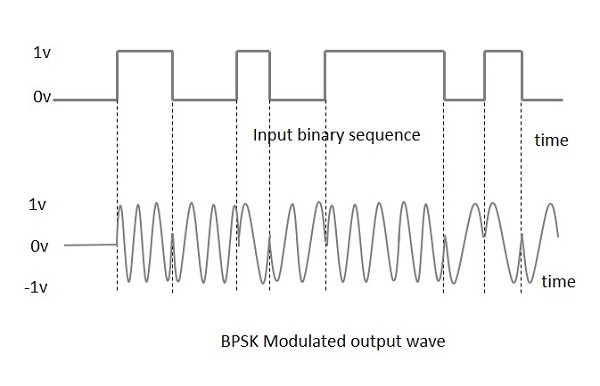BPSK Modulator |BPSK Demodulator | advantages of BPSK | disadvantages of BPSK | BPSK Applications |
Binary Phase Shift Keying BPSK
This is also called as 2-phase PSK or Phase Reversal Keying. In this technique, the sine wave carrier takes two phase reversals such as 0° and 180°.
BPSK is basically a Double Side Band Suppressed Carrier DSBSC modulation scheme, for message being the digital information.
The block diagram of Binary Phase Shift Keying consists of the balance modulator which has the carrier sine wave as one input and the binary sequence as the other input. Following is the diagrammatic representation.
The modulation of BPSK is done using a balance modulator, which multiplies the two signals applied at the input. For a zero binary input, the phase will be 0° and for a high input, the phase reversal is of 180°.
Following is the diagrammatic representation of BPSK Modulated output wave along with its given input.
The output sine wave of the modulator will be the direct input carrier or the inverted 180°phaseshifted input carrier, which is a function of the data signal.
BPSK Demodulator
The block diagram of BPSK demodulator consists of a mixer with local oscillator circuit, a bandpass filter, a two-input detector circuit. The diagram is as follows.
By recovering the band-limited message signal, with the help of the mixer circuit and the band pass filter, the first stage of demodulation gets completed. The base band signal which is band limited is obtained and this signal is used to regenerate the binary message bit stream.
In the next stage of demodulation, the bit clock rate is needed at the detector circuit to produce the original binary message signal. If the bit rate is a sub-multiple of the carrier frequency, then the bit clock regeneration is simplified. To make the circuit easily understandable, a decision-making circuit may also be inserted at the 2nd stage of detection.
Following are the benefits or advantages of BPSK:
➨It is most robust modulation technique due to the fact that binary 1 and 0 are separated by 180 degree phase shift of the carrier. Due to this property, BPSK modulated data can travel longer distances when transmitted from base station or subscriber stations. Hence BPSK modulation is employed in pilot carrier as well as in preamble sequences. These are used for time/frequency synchronization and channel estimation/equalization purpose.
➨Due to above, BPSK modulation is used by most of the cellular towers for long distance communication or transmission of the data.
➨BPSK demodulator requires to make only two decisions in order to recover original binary information. Hence BPSK receiver is very simple compare to other modulation types.
➨BPSK is power efficient modulation technique as less power is needed to transmit the carrier with less number of bits.
Following are the disadvantages of BPSK:
➨In BPSK modulation, one bit is carried by one single analog carrier. Hence data rate in bits per second is same as the symbol rate. This is half in comparison to the QPSK modulation technique and many times less compare to other higher modulation techniques such as 16QAM, 64QAM etc.
➨Due to above reason, BPSK is not bandwidth efficient modulation technique compare to other modulation types.
BPSK Applications
The BPSK modulation is a very basic technique used in various wireless standards such as CDMA, WiMAX (16d, 16e), WLAN 11a, 11b, 11g, 11n, Satellite, DVB, Cable modem etc. It is considered to be more robust among all the modulation types due to difference of 180 degree between two constellation points. Hence it can withstand severe amount of channel conditions or channel fading. It is used in OFDM and OFDMA to modulate the pilot subcarriers used for channel estimation and equalization. As we know different channels are used for specific data transmission in cellular systems. The channels used to transmit system related informations which are very essential are modulated using BPSK modulation.
Following are the benefits or advantages of BPSK:
➨It is most robust modulation technique due to the fact that binary 1 and 0 are separated by 180 degree phase shift of the carrier. Due to this property, BPSK modulated data can travel longer distances when transmitted from base station or subscriber stations. Hence BPSK modulation is employed in pilot carrier as well as in preamble sequences. These are used for time/frequency synchronization and channel estimation/equalization purpose.
➨Due to above, BPSK modulation is used by most of the cellular towers for long distance communication or transmission of the data.
➨BPSK demodulator requires to make only two decisions in order to recover original binary information. Hence BPSK receiver is very simple compare to other modulation types.
➨BPSK is power efficient modulation technique as less power is needed to transmit the carrier with less number of bits.
Following are the disadvantages of BPSK:
➨In BPSK modulation, one bit is carried by one single analog carrier. Hence data rate in bits per second is same as the symbol rate. This is half in comparison to the QPSK modulation technique and many times less compare to other higher modulation techniques such as 16QAM, 64QAM etc.
➨Due to above reason, BPSK is not bandwidth efficient modulation technique compare to other modulation types.
BPSK Applications
The BPSK modulation is a very basic technique used in various wireless standards such as CDMA, WiMAX (16d, 16e), WLAN 11a, 11b, 11g, 11n, Satellite, DVB, Cable modem etc. It is considered to be more robust among all the modulation types due to difference of 180 degree between two constellation points. Hence it can withstand severe amount of channel conditions or channel fading. It is used in OFDM and OFDMA to modulate the pilot subcarriers used for channel estimation and equalization. As we know different channels are used for specific data transmission in cellular systems. The channels used to transmit system related informations which are very essential are modulated using BPSK modulation.








0 Comments